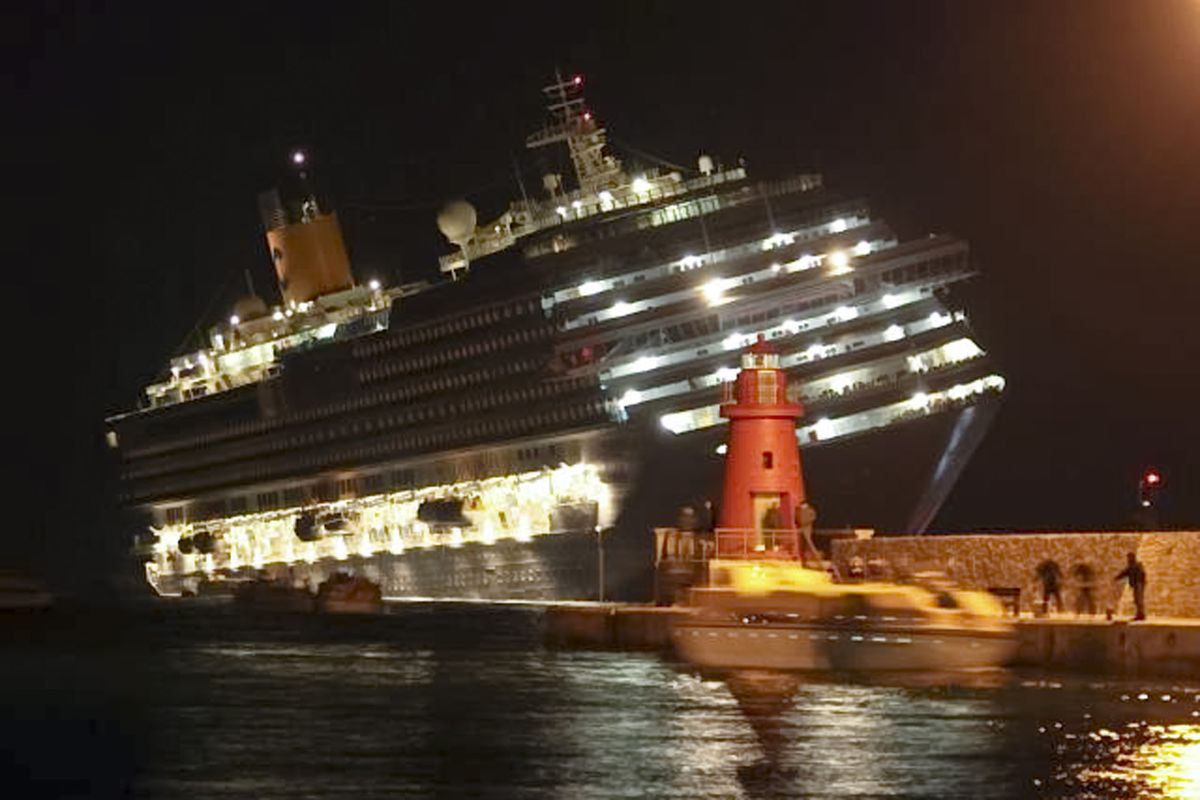Witnesses: Captain steered too close to reefs, fled amid chaos
Schettino detained as evidence mounts

GIGLIO, Italy – Maritime authorities, passengers and mounting evidence pointed Sunday toward the captain of a cruise liner that ran aground and capsized off the Tuscan coast, amid accusations that he abandoned ship before everyone was safely evacuated and was showing off when he steered the vessel far too close to shore.
Divers searching the murky depths of the partially submerged Costa Concordia found the bodies of two elderly men still in their life jackets, bringing the confirmed death toll to five. At least 15 people were still missing, including two Americans.
The recovered bodies were discovered at an emergency gathering point near the restaurant where many of the 4,200 on board were dining when the luxury liner struck rocks or a reef off the tiny island of Giglio. The Italian news agency ANSA reported the dead were an Italian and a Spaniard.
Meanwhile, attention focused on the captain, who was spotted by Coast Guard officials and passengers fleeing the scene even as the chaotic and terrifying evacuation was under way.
The ship’s Italian owner, a subsidiary of Carnival Cruise lines, issued a statement late Sunday saying there appeared to be “significant human error” on the part of the captain, Francesco Schettino, “which resulted in these grave consequences.”
Authorities were holding Schettino for suspected manslaughter and a prosecutor confirmed Sunday they were also investigating allegations the captain abandoned the stricken liner before all the passengers had escaped.
According to the Italian navigation code, a captain who abandons a ship in danger can face up to 12 years in prison.
A French couple who boarded the Concordia in Marseille, Ophelie Gondelle and David Du Pays, told the Associated Press they saw the captain in a lifeboat, covered by a blanket, well before all the passengers were off the ship.
“The commander left before and was on the dock before everyone was off,” said Gondelle, 28, a French military officer.
“Normally the commander should only leave at the end,” said Du Pays, a police officer who said he helped an injured passenger to a rescue boat. “I did what I could.”
Coast Guard officers later spotted Schettino on land as the evacuation unfolded.
The officers urged him to return to his ship and honor his duty to stay aboard until everyone was safely off the vessel, but he ignored them, Coast Guard Cmdr. Francesco Paolillo said.
Schettino insisted he didn’t leave the liner early, telling Mediaset television that he had done everything he could to save lives.
“We were the last ones to leave the ship,” he said.
‘Too close, too close’ to reef area
Questions also swirled about why the ship had navigated so close to the dangerous reefs and rocks that jut off Giglio’s eastern coast, amid suspicions the captain may have ventured too close while carrying out a maneuver to entertain tourists on the island.
The ship’s owner, Costa Crociere SpA, issued a statement late Sunday saying it was working with investigators to determine “precisely what went wrong aboard the Costa Concordia.”
“While the investigation is ongoing, preliminary indications are that there may have been significant human error on the part of the ship’s master, Captain Francesco Schettino, which resulted in these grave consequences,” the statement said.
“The route of the vessel appears to have been too close to the shore, and the captain’s judgment in handling the emergency appears to have not followed standard Costa procedures.”
Residents of Giglio said they had never seen the Costa come so close to the dangerous “Le Scole” reef area.
“This was too close, too close,” said Italo Arienti, a 54-year-old sailor who has worked on the Maregiglio ferry between Giglio and the mainland for more than a decade. Pointing to a nautical map, he drew his finger along the path the ship usually takes and the jarring one close to shore that it followed Friday.
The ship was a mere 150 yards from shore at the time of the grounding, ANSA quoted Grosseto prosecutor Francesco Verusio as saying.
Schettino insisted he was twice as far out and said the ship ran aground because the rocks weren’t marked on his nautical charts.
However, he did concede he was maneuvering the ship in “touristic navigation” – implying a route that was a deviation from the norm and designed to entertain the tourists.
“We were navigating approximately 300 meters (yards) from the rocks,” he told Mediaset television. “There shouldn’t have been such a rock. On the nautical chart it indicated that there was water deep below.”
Coast Guard Cmdr. Filippo Marini said divers had recovered the “black box,” with the recording of the navigational details, from a compartment now under water, though no details were released.
Search continues for survivors
Meanwhile, rescue work continued into the night on the unsubmerged half of the Concordia, said firefighters spokesman Luca Cari. Sniffer dogs were being brought in, although it was unclear if they could adapt to working in an environment where the horizontal became the vertical, due to the 90-degree list of the ship.
Marini, the coast guard captain, held out hope there could still be survivors, perhaps holed up in the section still above water, or that some of the unaccounted passengers simply didn’t report their safe arrival on land.
Earlier Sunday, a helicopter airlifted a cabin crew member from the capsized hulk just hours after South Korean honeymooners were rescued from their cabin when firefighters heard their screams.
A relative of the rescued crewman told reporters he had survived two nights in darkness and with his feet in water.
Besides the two dead discovered Sunday, the bodies of three other victims – two French passengers and a Peruvian crewman – were pulled out of the sea in the hours after the accident.